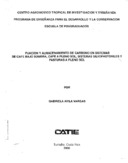Fijación y almacenamiento de carbono en sistemas de café bajo sombra, café a pleno sol, sistemas silvopastoriles y pasturas a pleno sol
Alternative title
Carbon fixation and storage in shaded coffee systems, completely unshaded coffee, silvopastoral systems and unshaded pastures
Description
Tesis (Mag. Sc.)--CATIE, Turrialba (Costa Rica), 2000 99 páginas 8 figuras. 63 tablas. Referencias en las páginas 67-80
Résumé
El objetivo de la investigación consistió en cuantificar el carbono fijado y almacenado en sistemas agroforestales con café y pastos en Costa Rica. Los sistemas evaluados fueron: Coffea. arabica con Eucaliptus. deglupta de cuatro años de edad; Coffea arabica con Eucaliptus deglupta de seis años de edad; Coffea. arabica con E. deglupta de ocho años de edad; Coffea. arabica con E. poeppigiana > 10 años de edad; Coffea arabica a plena exposición solar, en el Valle Central; los sistemas con pasturas fueron: Brachiaria brizantha con Acacia mangium de tres años de edad; Brachiaria brizantha con E. deglupta de tres años de edad; Brachiaria brizantha e Ischaemun indicum a plena exposición solar en la Región Atlántica. En los sistemas de producción con café se evaluaron los componentes árbol, cafeto, hojarasca y suelo, mientras que en los sistemas de producción con pastos se evalúo la pastura, el árbol y el suelo. Los resultados obtenidos mostraron que en promedio los sistemas agroforestales café-eucalipto almacenaron 40percent más carbono que los sistemas silvopastoriles brizanta-eucalipto y brizanta-mangium. En promedio los sistemas agroforestales almacenan más carbono que los sistemas correspondientes a los cultivos a pleno sol, éste comportamiento fue más evidente en los sistemas silvopastoriles. Más del 89por ciento del carbono almacenado en los sistemas de producción estudiados, corresponden al carbono del suelo; éste varió entre el 89.8por ciento (120.92 t C ha-1) en sistemas agroforestales café-eucalipto de 8 años a 99.9por ciento (84.31 t C ha-1) en la pastura natural ratana (I. indicum). En los sistemas de producción con café, el asocio café-poró fue el de mayor almacenamiento de carbono (195 t ha-1), mientras que el café-eucalipto de 8 años tuvo el más bajo (120.92 t ha-1); el café en monocultivo almacenó más carbono que el café de cuatro y ocho años. Considerando el carbono almacenado por los árboles maderables en los sistemas agroforestales con café y los sistemas silvopastoriles, la cantidad de carbono almacenada se encuentra muy cercana y superior a la presentada en plantaciones puras (5.74 t C ha-1), reportadas para el País. Los sistemas agroforestales con café y los sistemas silvopastoriles almacenan el componente arbóreo cantidades elevadas de carbono, por lo que deberían de ser incluidos en la modalidad por pago de servicios ambientales que regula la Ley Forestal de Costa Rica. El monto pagado por el servicio ambiental de almacenamiento de carbono para proyectos nacionales e internacionales son superiores a los pagados actualmente a los productores como pago de servicio ambiental. The objective of the study was to quantify fixed and stored carbon in agroforestry systems with coffee and pastures in Costa Rica. The systems evaluated were: Coffea. arabica with four-year-old Eucaliptus. deglupta; Coffea arabica with six-year-old Eucaliptus deglupta; Coffea. arabica with eight-year-old E. deglupta; Coffea. arabica with 10-year or older E. poeppigiana; completely unshaded Coffea arabica, in the Central Valley; the systems with pastures were: Brachiaria brizantha with three-year-old Acacia mangium; Brachiaria brizantha with three-year-old E. deglupta; completely unshaded Brachiaria brizantha; and completely unshaded Ischaemun indicum in the Atlantic Region. Trees, coffee bushes, fallen leaves and soils in production systems with coffee were evaluated, while pastures, trees, and soils were evaluated in production systems with pastures. Results obtained showed that on average, the coffee-eucalyptus agroforestry systems stored 40percent more carbon than the brizantha-eucalyptus and brizantha-mangium silvopastoral systems. On average, agroforestry systems store more carbon that systems corresponding to unshaded crops; this behavior was more evident in silvopastoral systems. More that 89percent of the carbon stored in the production systems studied corresponds to carbon in the soil; this varied between 89.8percent (120.92 t C ha-1) in eight-year-old coffee-eucalyptus agroforestry systems and 99.9percent (84.31 t C ha-1) in the natural rattan pasture (I. indicum). In the production systems with coffee, the coffee-poro association showed the best carbon storage (195 t ha-1), while the eight-year-old coffee-eucalyptus system had the lowest figure (120.92 t ha-1); coffee in a mono-cropping system stored more carbon than four or eight-year-old coffee. Considering that carbon stored by timber trees in agroforestry systems with coffee and in silvopastoral systems, the amount of stored carbon is very similar or higher than that found in pure plantations (5.74 t C ha-1), as reported for the country. Agroforestry systems with coffee and the tree component of silvopastoral systems store great quantities of carbon, and for this reason, should be included in the environmental services payment regulated by Costa Rica's Forestry Law. The amounts paid to national and international projects for the environmental service of carbon storage are greater than those presently paid to producers as a payment for this service.
Keywords
ACACIA MANGIUM, AGROFORESTERIA, ALMACENAMIENTO, ALMACENAMIENTO DE CARBONO, BRACHIARIA BRIZANTHA, CAPTURA DEL CARBONO ATMOSFERICO, COFFEA ARABICA, DIOXIDO DE CARBONO, ERYTHRINA POEPPIGIANA, ESTIMACION, EUCALYPTUS DEGLUPTA, FIJACION DEL NITROGENO, ISCHAEMUN INDICUM, PASTIZALES, SERVICIOS AMBIENTALES, SISTEMAS SILVOPASCICOLAS, SISTEMAS SILVOPASTORILES, SOMBRA, AGROFORESTRY, CARBON DIOXIDE, PASTURES, SHADE, SILVOPASTORAL SYSTEMS, STORAGE, VALUATION,
Asesor
Jiménez, Francisco
Éditeur
CATIE, Turriaba (Costa Rica)
Collections
- Tesis [3069]


